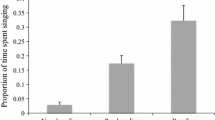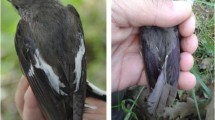Summary
Several aspects of nest defence behavior were investigated in song sparrows (Melospiza melodia) in eastern Ontario. Two independent tests were made of the hypothesis that the increase in nest defence observed through a nesting attempt is due to the birds becoming familiar with the nest threat, rather than because the nest contents increase in value to the parents. Neither test supported the hypothesis. As predicted by life history theory for species with age-independent mortality, males did not defend their nest more vigorously as they become older. Parents defended their nests less vigorously through the breeding season, contrary to the expected pattern of increased nest defence in response to declining renesting potential. This result may be attributable to a decline in offspring value through the breeding season. Nest defence behavior of mated individuals was positively correlated, independent of factors such as offspring age, renesting potential and brood size. From this result it is proposed that a source of variation in nest defence behavior may be individuals basing their own response on their mate's response in a positive feedback fashion. Males defended nests less vigorously than females, consistent with the expectation that males have lower certainty of parentage in the offspring. It is proposed that variation in paternal uncertainty could contribute to the unexplained variation reported in nest defence studies.
Similar content being viewed by others
References
Andersson M, Wiklund CG, Rundgren H (1980) Parental defence of offspring: a model and an example. Anim Behav 28:536–542
Arcese P, Smith JNM (1985) Phenotypic correlates and ecological consequences of dominance in song sparrows. J Anim Ecol 54:817–830
Barash DP (1975) Evolutionary aspects of parental behavior: distraction behavior of the alpine accentor. Wilson Bull 87:367–373
Barash DP (1980) Predictive sociobiology: mate selection in damselfishes and brood defence in white-crowned sparrows. In: Barlow GW, Silverberg J (eds) Sociobiology: beyond nature/nurture? AAAS, Washington, pp 209–226
Blancher PJ, Robertson RJ (1982) Kingbird aggression: Does it deter predation? Anim Behav 30:929–930
Breitwisch R (1988) Sex differences in defence of eggs and nestlings by northern mockingbirds Minus polyglottus. Anim Behav 36:62–72
Brunton DH (1986) Fatal antipredator behavior of a killdeer. Wilson Bull 98:605–607
Coleman RC (1987) Does experience with predators affect parental investment? Auk 104:791–792
Curio E (1975) The functional organization of anti-predator behavior in the pied flycatcher: a study of avian visual perception. Anim Behav 23:1–115
Curio E, Regelmann K (1985) The behavioural dynamics of great tits (Parus major) approaching a predator. Z Tierpsychol 69:3–18
Curio E, Regelmann K, Zimmermann U (1984) The defence of first and second broods by great tit (Parus major) parents: a test of predictive sociobiology. Z Tierpsychol 66:100–127
Deevey ES Jr (1947) Life tables for natural populations of animals. Quart Rev Biol 22:283–314
Eckert CG, Weatherhead PJ (1987) Male characteristics, parental quality and the study of mate choice in the red-winged blackbird (Agelaius phoeniceus). Behav Ecol Sociobiol 20:35–42
Goodman O (1974) Natural selection and a cost ceiling on reproductive effort. Am Nat 108:247–268
Greig-Smith PW (1980) Parental investment in nest defence by stonechats (Saxicola torquata). Anim Behav 28:604–619
Halliburton R, Mewaldt LR (1976) Survival and mobility in a population of Pacific coast song sparrows (Melospiza melodia gouldii). Condor 78:499–504
Knight RL, Temple SA (1986a) Nest defence in the American goldfinch. Anim Behav 34:887–897
Knight RL, Temple SA (1986b) Why does intensity of avian nest defence increase during the nesting cycle? Auk 103:318–327
Lack D (1946) Do juvenile birds survive less well than adults? British Birds 39:258–264
Loery G, Pollock KH, Nichols JD, Hines JE (1987) Age-specificity of black-capped chickadee survival rates: analysis of capture-recapture data. Ecology 68:1038–1044
Moller AP (1984) Parental defence of offspring in the barn swallow. Bird Behav 5:110–117
Moller AP (1988) Paternity and paternal care in the swallow, Hirundo rustics. Anim Behav 36:996–1005
Montgomerie RD, Weatherhead PJ (1988) Risks and rewards of nest defence by parent birds. Quart Rev Biol 63:167–187
Nol E, Smith JNM (1987) Effects of age and breeding experience on seasonal reproductive success in the song sparrow. J Anim Ecol 56:301–313
Pianka ER, Parker WS (1975) Age-specific reproductive tactics. Am Nat 109:456–464
Pugesek BH (1983) The relationship between parental age and reproductive effort in the California gull (Larus californicus). Behav Ecol Sociobiol 13:161–171
Pugesek BH (1987) Age-specific survivorship in relation to clutch size and fledging success in California gulls. Behav Ecol Sociobiol 21:217–221
Regelmann K, Curio E (1983) Determinants of brood defence in the great tit Parus major L. Behav Ecol Sociobiol 13:131–145
Ricklefs RE (1973) Ecology. Chiron Press, New York
Ricklefs RE (1974) Fecundity, mortality and avian demography. In: Farner DS (ed) Breeding biology of birds. Nat Acad Sci Washington, pp 336–435
Trivers RL (1972) Parental investment and sexual selection. In: Campbell B (ed) Sexual selection and the descent of man 1871–1971. Aldine, Chicago, pp 136–179
Weatherhead PJ (1979) Do savannah sparrows commit the Concorde fallacy? Behav Ecol Sociobiol 5:373–381
Weatherhead PJ (1982) Risk taking by red-winged blackbirds and the Concorde fallacy. Z Tierpsychol 60:199–208
Weatherhead PJ, Boak KA (1986) Site infidelity in song sparrows. Anim Behav 34:1299–1310
Westneat DF (1988) Male parental care and extrapair copulations in the indigo bunting. Auk 105:149–160
Williams GC (1966) Natural selection, costs of reproduction and a refinement of Lack's principle. Am Nat 100:687–690
Author information
Authors and Affiliations
Rights and permissions
About this article
Cite this article
Weatherhead, P.J. Nest defence by song sparrows: methodological and life history considerations. Behav Ecol Sociobiol 25, 129–136 (1989). https://doi.org/10.1007/BF00302929
Received:
Accepted:
Issue Date:
DOI: https://doi.org/10.1007/BF00302929




